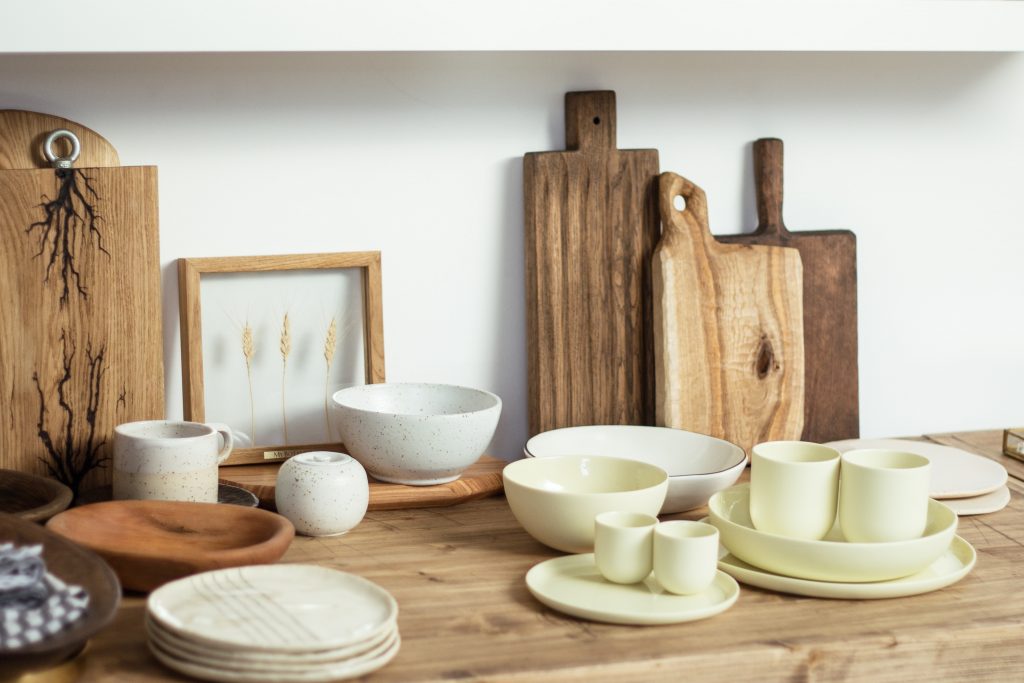Did you hear about the Chinese melamine baby formula scandal of 2008, causing at least six deaths and hundreds of thousands of babies to develop kidney stones or renal failure?
Or possibly you remember the 2007 United States pet food scare which resulted in thousands of dog and cat fatalities and was linked to Chinese-imported wheat, rice, and protein supplements containing melamine?
Unfortunately, the melamine toxicity issue is far from over.
When it comes specifically to cutlery, cups, plates, and bowls made with this type of plastic, you’re likely wondering: is melamine safe? Find out everything you need to know about melamine tableware and safer alternatives here.
Table of Contents
- What Exactly is Melamine?
- Is Melamine Toxic?
- Accidental Ingestion of Melamine
- Pharmaceuticals Made with Melamine
- Melamine from the Pesticide, Cyromazine
- Melamine from Chlorine-Containing Disinfectants
- What is Melamine Found In?
- Melamine in Tableware and Kitchenware
- What is Melamine Dishware Made From?
- Can Melamine Dishware Be Recycled?
- Is Melamine Regulated for Safety?
- Are Melamine Dishes Safe?
- Melamine and Hot Foods and Beverages
- Is Melamine Microwave Safe?
- Is Melamine Dishwasher Safe?
- Melamine and Acidic Foods and Beverages
- Melamine and Oily or Fatty Foods
- Alternatives to Melamine Dishware
- Wrap Up on Melamine Tableware
What Exactly is Melamine?
Melamine is a high-volume industrial chemical consisting mostly of the elements carbon and nitrogen. It’s also the name for the plastic made from the chemicals melamine and formaldehyde (which is a known carcinogen).
Melamine is a byproduct of the coal industry.
Commercially, melamine is made starting with urea (yes, that’s the major organic component of human urine!). Since synthetic fertilizers contain urea, melamine production is often coupled with it. In the U.S., melamine can no longer be used in fertilizer; however, in other countries, it can be used alone as fertilizer or as an additive. In fact, large quantities of ammonia given off during melamine production feed directly back into creating more urea to make even more melamine and fertilizer.
Interestingly, melamine is used as a fertilizer in some countries, but it is not approved for this purpose in the United States.
What’s the Difference Between Melamine and Plastic?
Melamine and plastic are not necessarily different. Rather, melamine is a component of certain types of plastic, as noted above.
Home
Best Non-Toxic Outdoor Dinnerware for Picnics, BBQs, and more!
Typical outdoor plates, cups, and cutlery contain toxins like phthalates and PFAS. Learn more about the toxic chemicals in outdoor dinnerware and then get our recommended brands.
Is Melamine Toxic?
What are the potential dangers of melamine to your and your family? The carbon-nitrogen bonds in melamine are somewhat similar to those in cyanide in terms of their chemical reactivities. Have you heard of cyanide poisoning? It’s the carbon-nitrogen bonding in cyanide that leads to its toxicity.
So, it’s no surprise that some of the breakdown products of melamine have cyanide-sounding names: cyanic and cyanuric acids. This explains why melamine ingestion, in large enough amounts, could kill you — just like cyanide.

Accidental Ingestion of Melamine
There are several ways you could ingest melamine without knowing it. All of these exposures are part of your Total Daily Intake (TDI) for melamine.
Pharmaceuticals Made with Melamine
For instance, melamine is a starting material for many pharmaceuticals. The final drug products should be ultra-filtered and purified before sale to remove any residual melamine. The United States Food and Drug Administration (FDA) issued guidance for pharmaceutical companies to test for melamine to prevent unnecessary exposure to melamine and decreased drug effectiveness due to its presence.
While it’s possible that melamine could be present in the end product of certain pharmaceuticals, there have not been any known cases where this has occurred so far.
Melamine from the Pesticide, Cyromazine
Melamine can also form as a breakdown product of the pesticide, cyromazine. This pesticide is applied on various crops and used to control flies in livestock raising. In these cases, there could be residues of melamine that you inadvertently ingest when you consume foods or livestock that have been treated with cyromazine. (Another reason to consider going organic!)
Melamine from Chlorine-Containing Disinfectants
A common disinfectant used in food processing and approved for use in the U.S. is trichloromelamine. When this chemical decomposes, melamine is one of the products.
That means any food you eat that was processed on a surface sanitized with trichloromelamine likely contains a tiny amount of melamine.
Do you drink water from a public utility? It may have been disinfected with dichloroisocyanurate. The disinfection process could lead to the formation of cyanuric acid, a chemical breakdown product of melamine associated with the development of renal disease.
Home
Best Non-Toxic Lunch Boxes & Bags (for Kids & Adults!) in 2024
It’s important to avoid PVC, bisphenols, phthalates, & PFAS in your food storage. So here are the best non-toxic lunch boxes and bags for 2023.
What is Melamine Found In?
Because of its durable, scratch-proof, and flame-resistant characteristics, melamine is frequently used in building materials and coatings. In fact, melamine countertops, walls, and flooring are the most common examples of melamine in today’s world.
Other places where you could find melamine include:
- Cabinetry
- Furniture
- Whiteboards
- Adhesives & glues
- Concrete plasticizer
- Filters
- Insulating foam
- Cleaning products
Given that melamine and its chemical analogues are in so many household products and building materials, it should be no surprise that melamine has been detected in indoor air, according to a 2018 study. Although measured in small amounts, the potential health effects are not yet fully known.

Melamine in Tableware and Kitchenware
Melamine’s use in products that come in contact with food and beverages is widespread.
Practically unbreakable, brightly-colored children’s dish sets made of melamine, featuring popular superheroes or TV and movie characters, are mainstays in families with young children.
Melamine party plates, cutlery, and serving trays and utensils are also common in many households since they’re inexpensive, reusable, and very functional.
Other characteristics of melamine that make it suitable for eating and cooking purposes include:
- Shatter-proof
- Lightweight
- Heat-resistant
What is Melamine Dishware Made From?
To make tableware and kitchenware that shares the same name, melamine is chemically combined with carcinogenic formaldehyde to form melamine resin. It may also be called melamine formaldehyde.
There are different types of melamine-containing resins used for tableware. They vary depending on the amount of chemical crosslinking and/or other chemicals (like colorants) added during manufacture.
Researchers have shown the degree and type of crosslinking influences the amount of migration into foods. The “cheaper” the melamine tableware, the more migration into food occurs.
Home
Best Non-Toxic Paper Towels (Bamboo, Reusable, Unbleached, & More)
A look at the common toxins found in conventional paper towels, the best bamboo and unbleached paper towel brands, and other great alternatives.
Can Melamine Dishware Be Recycled?
Melamine products can be reused, so they are better than single-use plastic products. However, because of the type of plastic they are, called thermoset, melamine dinnerware and kitchenware are not capable of being melted down and remolded to form other things. Their plastic code is #7.
Although at very high temperatures melamine will melt, it cannot be reformed into something else. This means melamine is not recyclable on a commercial basis.
PSA: Please do not mix melamine with other plastics that could be recycled (especially #1 and #2). All of it could be rejected.
Is Melamine Regulated for Safety?
Both the 2007 pet food and 2008 baby formula crises were due to Chinese companies intentionally adding melamine to food and animal feed ingredients. They did this to boost nitrogen content of the final products.
Despite the U.S. policies that were put in place following these scandals,, Chinese regulation of food and feed additives (as well as products that come in contact with food) unfortunately remains sketchy today. This matters if you consume anything with Chinese-made ingredients.
Since melamine, by weight, is composed mostly of nitrogen, it’s a perfect candidate for this kind of food and feed adulteration. Plus, it’s in large supply in China.
How did this widespread contamination happen? Businesses took advantage of the fact that common lab methods of protein analysis couldn’t differentiate nitrogen from protein sources (like milk) and nitrogen from non-protein sources (like melamine). S0, some sneaky companies added cheap and readily available melamine to food and feed to boost nitrogen levels so their products would seem to be of higher quality and contain more protein — although in reality this was false.
Besides baby formula, rice flour, and wheat gluten, melamine has also been detected in milk and milk products, eggs, vegetables, candy, snack foods, frozen processed foods, and fish and livestock feed coming from or made in China.
Thankfully, more sophisticated lab methods exist today to better identify melamine adulteration in foods and feed.
FDA Regulation of Melamine
The U.S. Food and Drug Administration ruled after the melamine scandals that melamine cannot be directly added to food and feed. However, it is permissible to use it as an incidental additive in food packaging. In this case, the FDA doesn’t think migration into food is likely or significant.
Although the FDA now requires melamine testing in baby food, it does not mandate testing in pet food.
Initially, the FDA stated that it couldn’t determine a safe level in baby formula. But later, the federal agency said the permissible maximum level in infant formula is 1,000 parts per billion (ppb). For other human foods, it’s 2,500 ppb.
Expressed another way, the FDA ruled that the Tolerable Daily Intake (TDI) for melamine, in all foods except infant formula, was 0.63 mg/kg of body weight per day.
The FDA also noted that free residual melamine can remain in melamine formaldehyde resins. Over time, it can migrate into food. Once ingested, the residual melamine contributes to your TDI. In other words, the FDA confirmed that particles from the melamine plastics in your dishes can slowly leach into your food over time.
WHO Recommendations on Melamine Risk
After extensive study, the World Health Organization (WHO) devised its own Tolerable Daily Intake for melamine.
The WHO calls the small amount of melamine that is present in food from pesticide or drug residues, a “baseline” level, and says there are no known negative health consequences to this. If present at significantly higher levels, it’s called adulterated due to the intentional addition of melamine to boost protein levels artificially.
The problem, however, is that it can be difficult to separate out causes of melamine presence in humans.For instance, if livestock ingested feed that had intentionally-added melamine from pesticides on it, then meat, milk, or eggs that you eat could be a source, too, of your total body burden and daily intake. In that case, it’s not clear whether the resulting melamine level would be considered “baseline” or “adulterated.”
The WHO considers the combination of melamine with its breakdown product, cyanuric acid, to be more toxic than each one alone. However, no data exist on just how toxic they are together.
In studies assessed by WHO when it developed its recommendations, pets with kidney damage had developed stones or crystals composed of melamine-cyanuric acid complexes in the urinary tract or kidneys. These cats and dogs had been fed “scrap” melamine (impure melamine with cyanuric acid and other breakdown products).
By contrast, baby formula had been laced with relatively pure melamine. Instead of cyanuric acid, its chemical cousin, uric acid, (in the infants’ urine), combined with melamine to form melamine-uric acid complexes, resulting in kidney damage or death.
Based on its analysis, the WHO established a melamine TDI of 0.2 mg/kg of body weight per day, more than three times lower than that set by the FDA.
To put this value in perspective, the Chinese Center for Disease Control and Prevention reported that several contaminated infant formula samples contained melamine at intake levels of 8.6 to 23.4 mg/kg body weight per day. The highest level detected in baby food was 2,560 mg/kg powder!

Are Melamine Dishes Safe?
Melamine is approved by the FDA for use in kitchen utensils, tableware, and cutlery. But does this mean that it’s safe?
“Safe” means melamine will not leach into your food or drink before you consume it — or only minimally. But how much is too much?
In other words, how likely is it that you’d develop kidney stones, renal failure, or possibly neurological or reproductive problems from using melamine dishware?
So far, the FDA advises that melamine dinnerware is safe with cold and warm foods and beverages that have not been in contact for very long with the melamine dish, bowl, cup, or utensil.
However, a 2011 study showed that melamine migration into food from tableware was detectable at lower temperatures (86-104℉). Although it may be small, it still contributes to your TDI for melamine.
There are a few other situations where you’d definitely want to avoid melamine dishware.
Melamine and Hot Foods and Beverages
To avoid migration of melamine into your food or drink, be sure to keep below it below approximately 160℉. Above that temperature, the FDA determined that melamine migration is more likely.
The tiny amount of “left over” melamine (left over from when the melamine-formaldehyde resin was originally manufactured), in the presence of high heat, is free to wreak havoc on your health.
In practical terms, do not leave a melamine ladle in a soup you’ve brought to boiling (212℉) while cooking.
Is Melamine Microwave Safe?
Likewise, don’t microwave a melamine cup of tea or hot chocolate. Melamine dishes in a conventional oven are a no-no, too.
These recommendations are backed up by science. A study published in 2013 showed high levels of melamine in the urine samples of people who had eaten hot noodle soup out of melamine bowls compared to ceramic bowls.
Is Melamine Dishwasher Safe?
Manufacturers claim they are safe in dishwashers. What this likely means is that you can run melamine dishes through the dishwasher without them melting or becoming damaged. However, it doesn’t necessarily mean that plastic particles aren’t still being broken down and leached out by the heat.
Melamine and Acidic Foods and Beverages
Several studies on the effect of acidic foods and beverages on melamine leaching from dinnerware have been completed. The general conclusion is that strongly acidic consumables, like tomato soup or orange juice, should not be left for long (stored) in melamine containers because of a chemical migration risk.
So, keep your OJ in a glass carafe in the fridge instead.
Melamine and Oily or Fatty Foods
Dr. Anna Tang of the Centre for Food Safety in Hong Kong authored a document titled “Melamine-ware and Food Safety.” She recommends that melamine-ware should not be used to “hold hot oil or deep-fried foods.”
Chemical similarity between melamine and fatty substances makes it easy for melamine to migrate into them. This is true for all plastic types. Dr. Tang’s suggestion that hot — not cold — oils are the culprit relates back to the first point about melamine and hot foods.
Alternatives to Melamine Dishware
What are the safest plates to eat off of? Whether you’re looking to replace the melamine-ware you have or purchase tableware that’s melamine-free, you have many alternative materials to choose from.
- Stainless steel. Sturdy and long-lasting, steel tableware won’t break in the hands of little ones! Recommended for young families. Cups, plates and cutlery of all types available.
- Glass. Oven-safe or tempered glass is the ultimate choice if you’re concerned about any type of chemical migration into your food. Components in glass are the most unlikely to leach out, although recycled glass is more prone to it.
- Wood. More sustainable than both steel and glass, wood tableware won’t shatter like ceramic. Find out before making the purchase if questionable non-food grade oils were used to manufacture them. Make sure pesticides weren’t used to grow the trees, and no deforestation was involved, either.
- Ceramic. Watch out for contaminants in the clay or glazes, especially heavy metals, that could leach into food or beverages.
Whatever you choose, there’s no reason why you must select only one of these melamine-free options. Mix and match depending on user, food, or occasion.
Wrap Up on Melamine Tableware
Melamine is the name given to a common industrial chemical made from urea. It’s also the name for a durable plastic containing formaldehyde that’s common in the building industry.
Melamine can be used to make kitchenware and dinnerware, too.
Concerns arose about melamine’s safety in 2007 and 2008 when pet food and infant formula were intentionally adulterated with melamine to increase nitrogen content. Chinese companies did this to give a false appearance of higher quality. As a result, hundreds of thousands of cases of renal failure or kidney stones resulted, as well as thousands of deaths in pets and at least six in babies.
There is evidence from numerous scientific studies that melamine can leach into foods and beverages. This is especially likely with acidic foods or beverages, fatty or oily foods, and high temperatures.
Several alternatives to melamine tableware and kitchenware are on the market. As a result, it’s easy to avoid melamine in the kitchen and dining room today.
Melamine isn’t safe in the long run, so why risk you and your family’s exposure to toxic chemicals when you’re better off going with a melamine-free dishware set?!







